Conversation Starters Toolkit
The Conversation Starters Toolkit comprises resources specifically designed to facilitate reflection and dialogue on learning environments and outcomes, engaging non-academic stakeholders through participatory activities. The toolkit is based on the idea that acknowledging and comparing diverse perspectives fosters deeper, more solid knowledge.
Where does it come from?
This toolkit originates from the participatory activities carried out within CLEAR and builds upon both quantitative and qualitative research conducted throughout the project. Each set of tools has its own origin and purpose. Yet, they all share a common goal: to foster knowledge and mutual understanding within local contexts, encouraging all stakeholders to shift perspectives and make space for generative dialogue. Within CLEAR, the co-creation of visual outputs served as a testing ground for the above-mentioned dialogue and collaboration process. The outputs aimed to be both representative of the research findings and understandable to a wider public, so that they could act as effective conversation starters:
- Tool 1 – WP3_What if you lived elsewhere: developed two data visualisations based on the main findings of the quantitative research. Specifically, the report identified four European macro-regions that differ in terms of the opportunities available to young people. The team therefore decided to produce two outputs: one addressing individual perceptions and another offering a more descriptive overview of the regional characteristics.
- Tool 2 – WP4_What if you were them: translated key findings from interviews with policymakers in the field of education and training into three fictional stories. These stories were created to encourage discussions about biases and stereotypes related to young people.
- Tool 3 – WP5_What if you could hear their voice: selected one impactful quote per country from the narrative biographical interviews with young people.
- Tool 4 – WP6_What if you could change the educational system: produced a data visualisation highlighting one of the main findings from the survey with education policy experts, with the aim of fostering the debate on the future of education systems.
What is it for?
The toolkit is designed as a capacity-building tool for academic and independent researchers aiming to actively engage young people, education professionals, researchers, and policymakers within a collaborative research framework. Additionally, we believe it can be easily adapted to engage a wide range of stakeholders from diverse backgrounds. Aligned with this approach, all tools in this set can be used flexibly, adapting to the specific contextual needs and objectives defined by those facilitating a participatory process. The toolkit offers a range of suggestions and practical examples based on its conception, development, and testing throughout the project. The visual and graphic design of these tools has been created to be clear, inclusive, and accessible to everyone, whether young or adult, education experts or not.
The Toolkit is intended for use within a participatory process that has clearly defined objectives, an appropriate setting, and established guidelines for conducting and facilitating activities. Based on our participatory experience, we have developed a series of handbooks that share key insights and practical suggestions and are organized along the various phases of participatory events.
- Managing the opening session
An opening session should include:
- Participant Registration: set up a dedicated registration desk with a sign-in sheet and provide blank copies of the required Image Release Form for participants to fill in. Ensure that at least one staff member is available to assist with registration and form filling. If your core activity involves dividing participants into groups, you can manage this during registration, assigning the participant to a specific group through a label system (colour-based, image-based or naming-based).
- Opening session, usually held in plenary. Keep it brief and focus on providing essential information:
- Start with some welcoming words and mention the title of the event.
- Introduce the staff (names and their roles in the event). Do not forget to also mention the people in charge of the backstage activities of the event.
- Mention the location and the reasons for choosing it. This may be relevant to the event’s context.
- Provide a brief project or research presentation (a slideshow of 5 to 8 slides is suggested but it can be longer depending on the event’s objectives and participants’ level of expertise). Explain the participatory approach of the event, the research design, and what the project or research has carried out and discovered. Clearly state the aim of the event and the expected outcomes.
- Present the agenda of the day and its timing.
- Provide additional briefing if needed, such as practical information and safety regulations.
- Give a brief explanation on how you will work and the criteria for dividing participants into groups. Ask if anyone has any doubts or questions about the information and instructions provided.
- Finally, invite people to join the next session, which will focus on the core activities.
To encourage participants to introduce themselves, a few thematic inputs can be selected based on the research or project topics and turned into biographical questions about participants’ personal educational experiences. Here are some examples of ice-breaking questions used in small groups: What is the most useful thing you learned in school? And the least useful? Which teacher do you recall with affection and why? What’s the best advice you’ve ever been given when you were a student?
Concerning group division criteria, the choice of how to divide participants strongly depends on the aims of the activity. Specifically speaking about participative methods, we underline the importance of giving space for exchanging points of view between people with different profiles, so that their different expertise can meet. In such cases, creating mixed groups by profile (for example, gathering teachers and students, or professionals and policymakers) is an excellent choice to be able to generate a comparison between different visions and different sensitivities, while being careful to avoid potentially problematic matches due to power dynamics. Nevertheless, knowing participants’ profiles or backgrounds in advance is not always possible. If a pre-registration system is not feasible, group division may be managed using a random criterion. Still, once groups are formed, it is worth checking for a good level of variety and representativeness of expertise and background within each group. In cases where there is a large age gap between participants (e.g. young people and senior professionals), it is very important to evaluate whether the mixed groups are acceptable for the younger participants or whether they might feel uncomfortable. In such cases, allowing participants to form their own groups or adjusting group composition based on the preferences of younger participants- while still enabling opportunities for exchange – can help reinforce their sense of acceptance within the event.
In the following section, we offer a set of suggestions on how to start and develop a meaningful and generative discussion with participants. These are supported by four conversation starter tools designed within CLEAR and its participatory activities. A practical handbook has been created for each conversation starter to support potential users, including academics, researchers, and practitioners. Each handbook provides key information about the tool, including a visual preview, a brief description, its objectives, the topics it can help address, suggested ways to use it, and recommended timing for implementation.
Tool Handbook 1 – What if You Lived Elsewhere?

The Handbook compares individual and structural opportunities for young people across EU regions using research data and is based quantitative analyses of learning outcomes. The poster with graphic processing displays 4 coloured sticker layers to be placed on top of the poster. The output is available in Catalan, English, German, Italian, Portuguese, and Spanish.
Short description of the tool
This tool was inspired by the quantitative analyses conducted in WP3. The analyses focus on the connection between learning outcomes and opportunity structures – specifically, labour market and socio-economic conditions at the national and regional levels in Europe, considering changes from 2007 to 2021. The tool describes territorial opportunities across European regions. CLEAR research identified four categories, based on the type of job and the highest educational qualification that women and men living in the specified regional areas may aspire to. The categories were derived from the research but have been refined into four phrases (called labels) that reflect plausible statements made by people. In the first stage, the four labels are placed on a graph without levels. Participants are asked to use their knowledge and experience to indicate where they rank themselves based on their personal experience, and where they believe their region – or a specific region – ranks. In a second stage, levels derived from research data can be added to test participants’ suggestions.
For what purpose can it be used?
- To develop the quantitative research process by deepening reflection on selected topics such as spatial inequalities and regional or generational diversity;
- to promote the exchange of ideas among people with different roles and perspectives on research topics;
- to enhance each participant’s personal and professional perspective.
Which topics are addressed by the tool?
- Different perspectives on the relationship between level and degree of education and access to the labour market;
- The relationship between personal perception and evidence from data and research;
- The centrality of both diachronic and synchronic dimensions;
- Multiple factors that determine the relationship between education, training and the labour market;
- Coherence or mismatch between educational systems and the labour market.
The two main questions that the tool addresses are:
- What is the role of intermediate contextual factors, i.e., those concentric circles that play – or should play – a mediating function between the structural and the micro / family context?
- What role play mediators – primarily teachers – play in acknowledging and addressing vulnerabilities and the effects of unequal starting conditions? Do they serve an equalising or multiplying function?
Possible uses and suggested timing
Below is an example of a workshop outline tested in CLEAR, designed for a two-hour group session with five to ten participants, plus one facilitator and one note-taker.
- (5 minutes) Start with a general introduction of the project and present the meeting’s focus and objectives;
- (10 minutes) Introduce a discussion prompt and give participants a few minutes to gather their ideas and experiences (you can provide sticky notes for them to write down keywords);
- (40 minutes) Ask participants to introduce themselves and position on the label that best matches their personal experience, using a sticky note or a dot.
Figure 1 – Participants position a dot according to their personal experience

- (30 minutes) Present the sticky levels, asking participants to place their stickers on the label that best describes what they think is the general condition of the region where the activity is being conducted.
Figure 2 – Participants position the stickers according to their opinion
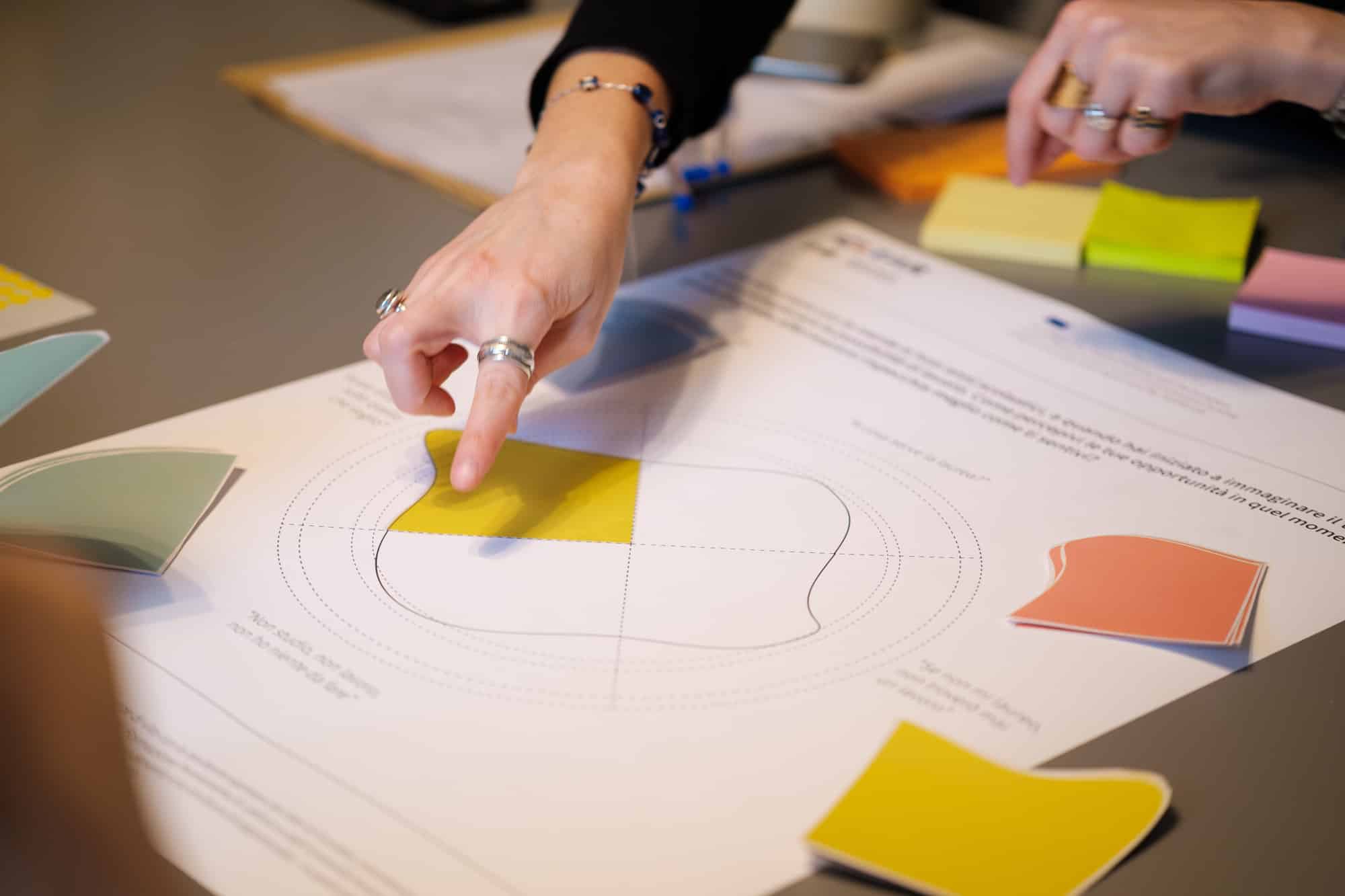
- (20 minutes) Following the conversation, briefly present the cross-sectional findings and engage in discussion.
Figure 3 – Participants are engaged in the discussion around research findings (labels) and their perceptions (stickers)
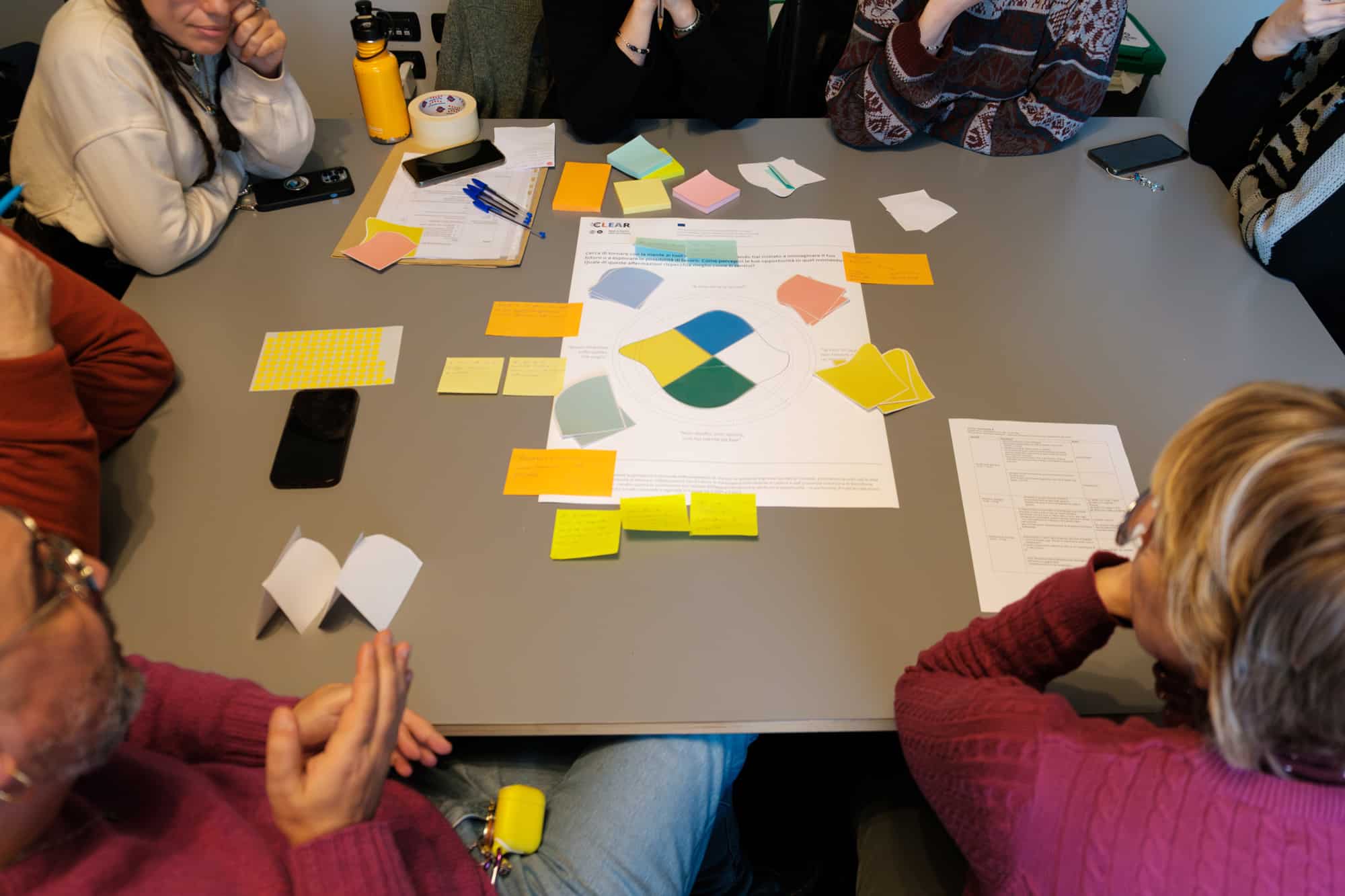
Tool Handbook 2 – What if You Were Them?


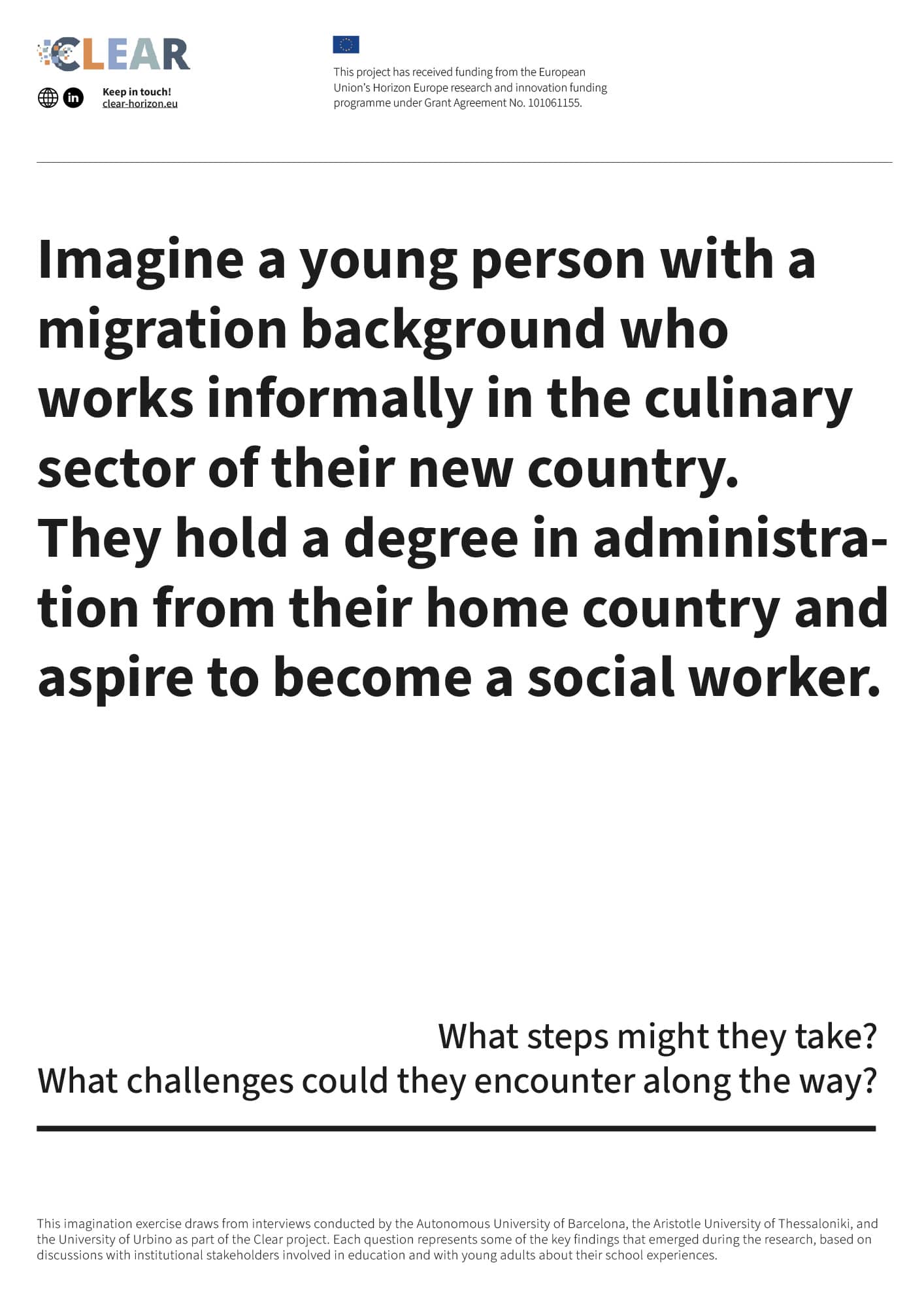
The Handbook explores multiple career paths through imaginative stories drawing from our institutional analysis, policy review and assessment. The 3 graphic outputs consist of a header with institutional logos, main section including a short biography with two guiding questions, and a footer explaining the creative process behind the output. The graphic output is available in Catalan, English, German, Greek, Italian, Portuguese, and Spanish and is designed for versatile use across different formats (A3 poster – for display on walls, A5/postcard – for easy distribution to participants, A4 sheet – allowing participants to take notes or write down thoughts during discussions).
Short description of the tool
The three selected stories are based on interviews with experts and students conducted in WP4 and highlight its key findings, in particular the emphasis on soft skills, the significance of spatial justice, and the impact of school evaluation on students’ career paths. These materials present plausible scenarios and pose open-ended questions to encourage reflection, critical thinking and group discussion. Stories and situations are presented concisely, revealing some information while leaving many aspects and details undefined. Participants are asked to use their knowledge and imagination to complete the story and answer certain questions about the paths of the different characters presented.
For what purpose can it be used?
- To integrate research findings, deepening reflection on selected topics such as spatial inequalities;
- To promote the exchange of ideas among people with different roles and perspectives on research topics;
- To enhance each participant’s personal and professional perspective.
Which topics are addressed by the tool?
- Different definitions and perspectives on inequality;
- Challenges in considering and enhancing learners’ diversity;
- Centrality of the spatial dimension;
- Ranking of knowledge and skills in different educational contexts;
- Multi-stakeholder governance and the challenges of coordinating different interventions;
- Evaluation of programs and policies;
- Coherence between educational systems and the labour market.
Possible options of use and suggested timing
Below is an example of a workshop outline tested in CLEAR, designed for a two-hour group session with five to ten participants, plus one facilitator and one note-taker.
- (5 minutes) Introduce the facilitators/researchers, present the general aim and focus of the meeting, and briefly summarise the project experience;
- (10 minutes) Introduce a discussion prompt and give participants a few minutes to gather their ideas and experiences (you can give them sticky notes to write down some keyword);
Figure 4 – Participants write down some keywords on sticky notes
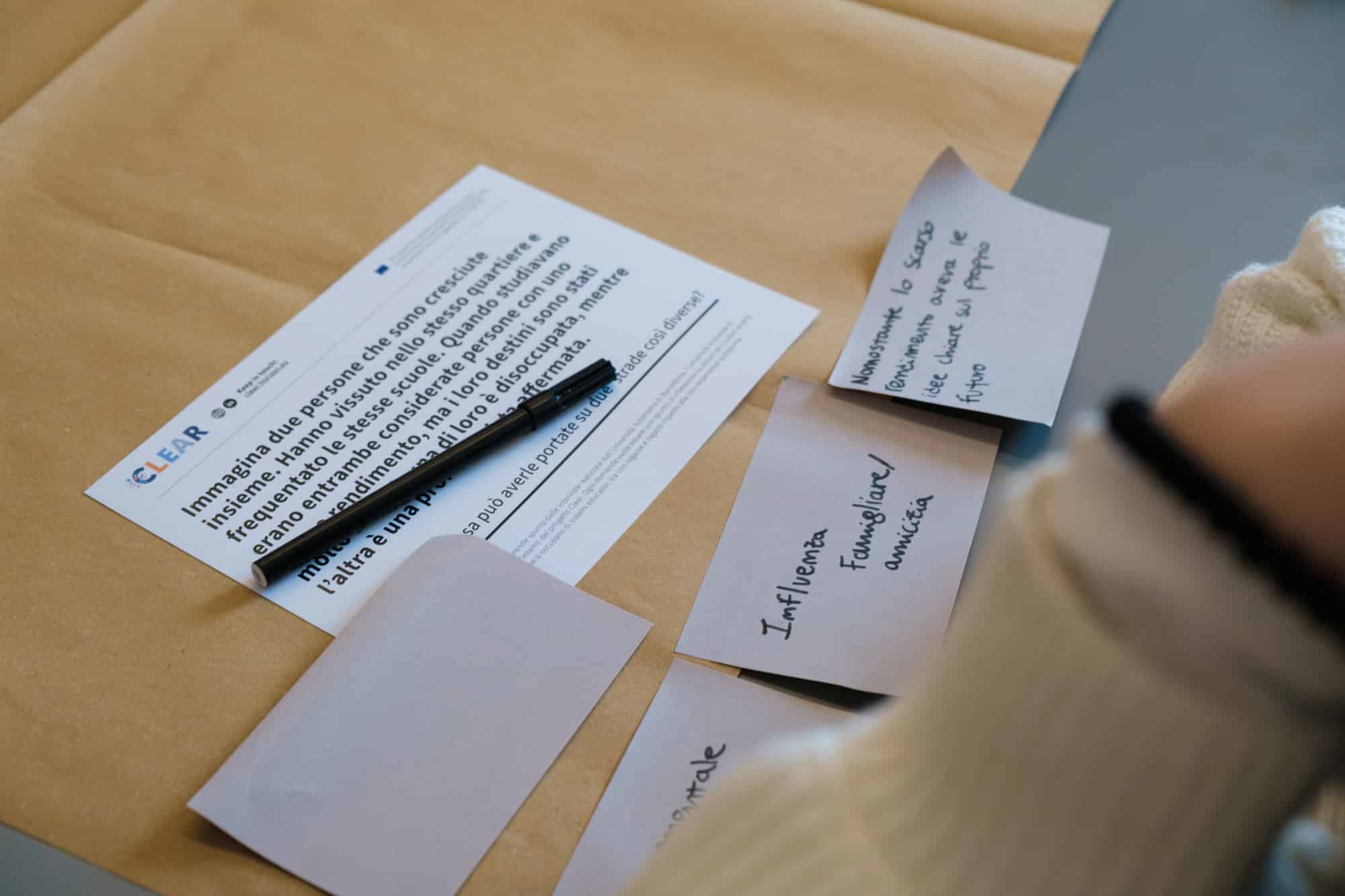
- (40 minutes) Ask participants to share their ideas and keywords in a first round of discussion;
- (15 minutes) After the conversation, briefly present cross-sectional research findings
- (30 minutes) Ask participants to share their ideas and keywords in a second round of discussion;
- (15 minutes) Ask participants to select 2/3 important keywords that inspire how educational systems function, then create a final word cloud together using sticky notes;
Figure 5 – Sharing of sticky notes in a final word cloud
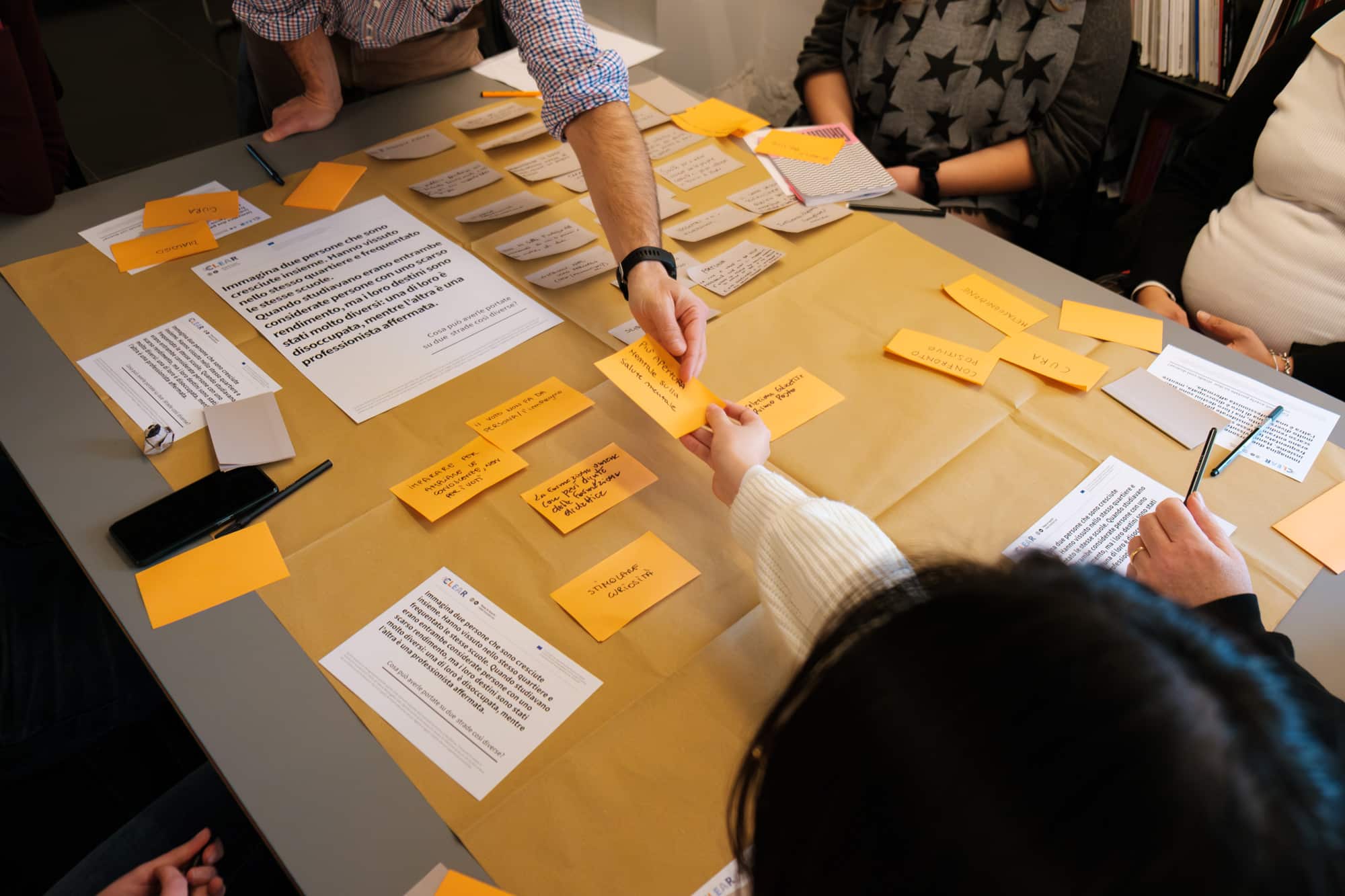
- (5 minutes) Final comments, feedback on the meeting and closing thanks.
Moreover, in a workshop, a stimulating discussion with participants could also be raised with alternative prompts:
- Imagine a person who was a brilliant student, praised by teachers for their interpersonal skills. Now, they’re unemployed. What might have happened?
- Imagine a person trained as a surgeon who now works as a professional caregiver. Why did they make this career shift?
- Imagine a person with limited language skills works only irregularly. Now, they aspire to become a social worker. What path might they follow?
- Picture someone with a university degree in agricultural sciences who now wants to shift careers and become a social worker. What steps might they take, and what challenges could they face along the way?
Tool Handbook 3 – What If You Could Hear Their Voices?

The Handbook contains excerpts from research interviews with young adults to spark discussions about education systems and refers to our qualitative research with young people. The poster is structured into four levels. The first level features an excerpt from the interview transcript related to the advice that students would like to give to decision-makers. The second level contains a statement in large, bold characters with a blurred effect, resembling a claim or a strong recommendation. The third level includes the actual quote, reporting the interviewee’s words and their thoughts on what should be done. The fourth level, with smaller text positioned at the bottom of the page, provides information about the project and the interviews conducted. The graphic output is designed for versatile use across different formats (A3 poster – for display on walls, A5 postcard – for easy distribution to participants, A4 sheet – allowing participants to take notes or write down thoughts during discussions). The output is available in Catalan, English, Finnish, German, Greek, Italian, Portuguese, and Spanish.
Short description of the tool
This tool presents an excerpt from an interview conducted with a young person during the research, focusing on the connection between relationships and motivation in educational contexts. Interview outlines and guidelines have been validated with selected groups of street-level professionals in Finland, Portugal, and Bulgaria. The final guidelines included a series of questions specifically aimed at clearly and directly eliciting the perspectives of young people on certain specific topics. The responses were included in the research process with the specific aim of publicly giving voice to the lived experiences and opinions of young adults, as well as stimulating debate on the main project topics. Starting from the verbatim transcription, the texts have been slightly edited, without substantial changes, to facilitate reading and graphic adaptation.
For what purpose can it be used?
- To deepen reflection on the project’s themes, especially inclusive learning environments;
- To highlight learners’ perspectives;
- To recognise and appreciate the different perspectives in the field;
- To promote self-awareness, empathy, and the ability to take on others’ perspectives.
Which topics are addressed by the tool?
- Learners’ perceptions and experiences of inclusion in learning environments;
- Learners ‘perceptions and experiences about justice and injustice in learning environments;
- The importance of interpersonal relationships, listening, and empathy in learning environments;
- Feelings of “constraint” and “freedom” and the role of motivation in educational relationships and environments;
- Recognition and appreciation of diversity in educational environments;
- Spatial inequalities;
- The connection between educational contexts and the future of our societies, including young people’s ideas about how to reform the educational system.
Possible uses and suggested timing
Below is an example of a workshop outline tested in the discussion session on inclusive learning environments, inspired by the words of young people and the personal experiences and views of the participants. This workshop is designed for a two-hour group session with five to ten participants, one facilitator, and one note-taker.
- (5 minutes) Start with a general update on the project and present the meeting’s focus and objectives.
- (5 minutes) Introduce this poster and other interview quotes. The materials can be displayed on the walls to encourage participants to move around and engage with them, or arranged in smaller printed formats on the table where participants sit, allowing them to share and read the materials.
Figure 6 – Introducing the excerpt from an interview conducted with a young person during the research
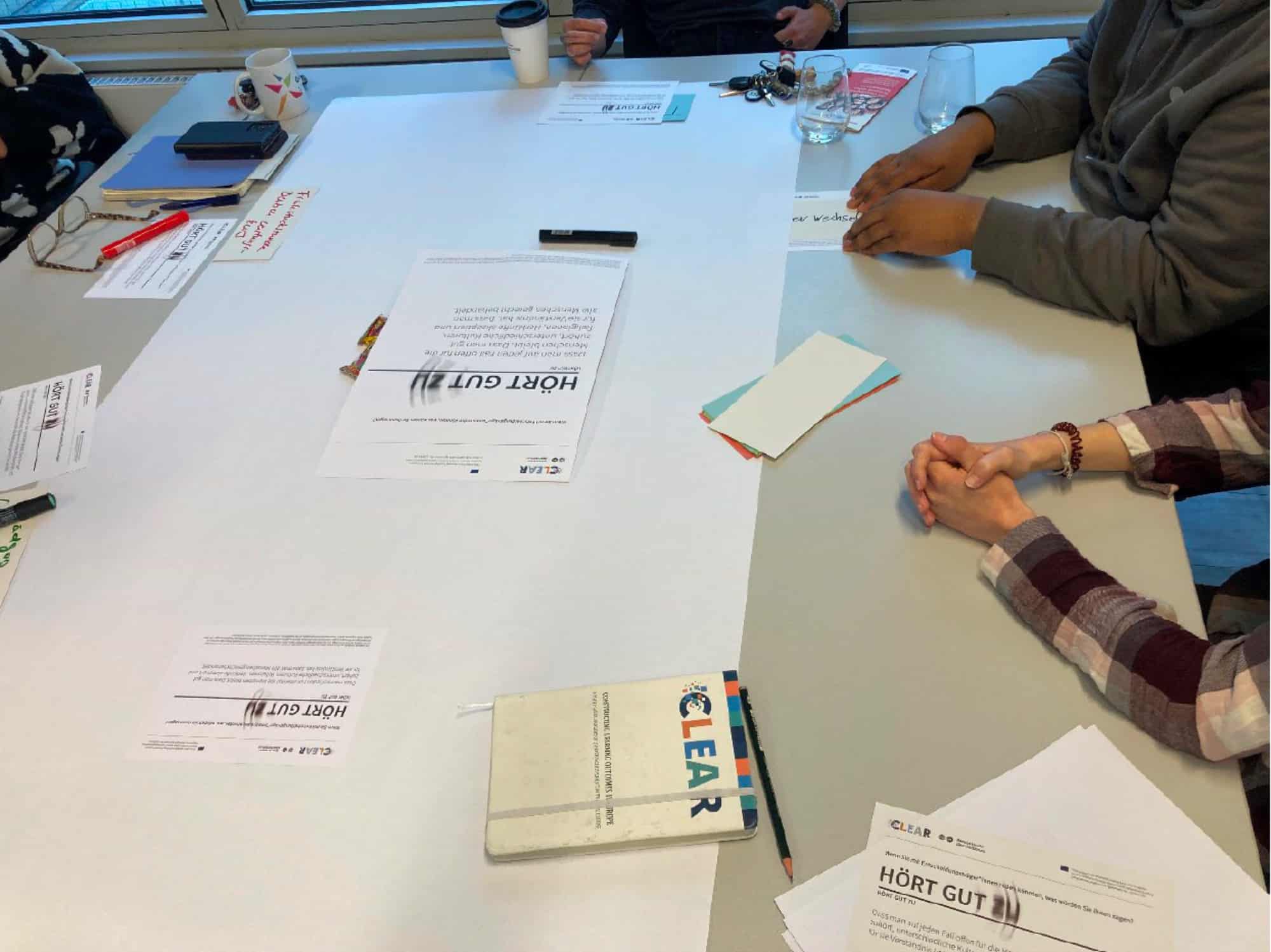
- (15 minutes) give participants some time to gather their ideas and experiences (you can give them sticky notes or paper to note down keywords). Then, give this instruction: “Carefully read these words from the interviews and reflect on your personal experiences of growth, education, and training. Identify a particularly positive episode regarding your relationship with the education and training system. Write a title for this episode on a sticky note.”
- (40 minutes) Ask participants to share their experiences and ideas in the first round of discussion.
- (15 minutes) Following the conversation, a researcher can briefly present WP5 findings and other relevant research results.
- (5 minutes) Instruction from the facilitator: “After listening to your colleagues’ stories and considering our findings, identify three key elements for building fully inclusive learning environments.”
- (30 minutes) Ask participants to share their ideas and keywords in a second round of discussion and create together a final concept map about inclusive learning environments.
- (5 minutes) Final comments from the facilitator, feedback on the meeting, and closing thanks.
Tool Handbook 4 – What If You Could Change the Educational System?

The Handbook focuses on the analysis of likely and desirable scenarios with experts, policymakers, and young adults and is based on our research with policy experts. The toolset includes a poster with an empty diagram labelled with three scenarios, a poster with a graph showing average responses on the likelihood of these scenarios, a poster with a graph showing average responses on the desirability of these scenarios, a poster with a graph combining likelihood and desirability, and separate layers (likelihood and desirability) available as add-ons to the main poster. All posters contain a header with the institutional logo, a main section including a short biography and two guiding questions, and a footer explaining the sources of the content. The graphic output is designed for versatile use across different formats (A2 poster – for display on walls, A3 poster – for display on walls or tables, suitable for small groups, A4 sheet – allowing participants to take notes or write down thoughts during discussions). The output is available in Catalan, English, Italian, Portuguese and Spanish.
Short description of the tool
The tool is a graph that represents the likelihood and desirability of three different scenarios through two coloured layers, based on experts’ responses to the survey questionnaire. The general picture of the likelihood and desirability of these three scenarios can be divided into three separate shapes: the empty shape showing the three scenarios; the yellow shape showing the average responses on the likelihood of each scenario; and the blue shape showing the average responses on the desirability of each scenario. The focus is particularly on the likelihood and desirability of three different scenarios:
- Statistical measurement of learning outcomes will become more important in policy-making arenas
- Measurement of learning outcomes will be used more frequently to sort and categorise learners (into achievement categories)
Merit and excellence will become more important in the policy debate.
These scenarios have been rephrased to be more accessible as follows:
- Decision-makers will pay more attention to test scores and other ways to measure learning
- Students will be sorted more often based on how well they perform in tests or assessments
- The idea of merit and excellence will become more important in education policy
The selection was based on the fact that these scenarios showed the largest gap between likelihood and desirability. This gap highlights a possible future area of discussion and divergence of points of view.
For what purpose can it be used?
- To discuss the probability and desirability of different future scenarios related to (statistical) measurement of learning outcomes, the role of merit and excellence, and their consequences for educational systems and individual careers;
- To present the general trends regarding these scenarios as identified by WP6 research with experts.
- To promote the exchange of ideas among people with different roles and perspectives on the research topics;
- To enhance the personal and professional perspectives of each participant regarding the future scenarios.
Which topics are addressed by the tool?
This tool is designed to start a group discussion about future scenarios concerning the role of statistical measurement of learning outcomes, as well as the evaluation and construction of merit and excellence. On one hand, the toolset can be used to foster discussion about future decisions in the educational policy arena. On the other hand, regardless of experts’ opinions, it can be used to:
- Share research results and the general trend on future educational scenarios with different groups, while also incorporating and comparing other perspectives (i.e. young people) alongside the experts’ opinions.
- Gather information on different groups’ representations and opinions about (statistical) measurement of learning outcomes, merit, and excellence, based on their lived, everyday experiences.
- Consider the possible consequences of these scenarios on individual lives at different levels.
- Foster discussion on possible long-term adjustments and/or changes to address the undesirability of these scenarios.
Possible uses and suggested timing
Below is an example outline of a workshop tested in CLEAR, designed for a 90-minute group session with five to ten participants, one facilitator, and one note-taker.
- (5 minutes) Start with a general update on the project/research and present the meeting focus and objectives.
- (5 minutes) Introduce poster (A). The poster (in A2 or A3) can be displayed on the walls to encourage participants to move around and engage with it, or it can be placed on the table where participants sit.
- (5 minutes) Ask participants to express their opinions about the likelihood and desirability of the three scenarios using coloured stickers: the closer to the centre, the more likely/desirable the scenario; the further from the centre, the less likely/desirable the scenario.
Figure 7 – A participant positioning bullets on the diagram
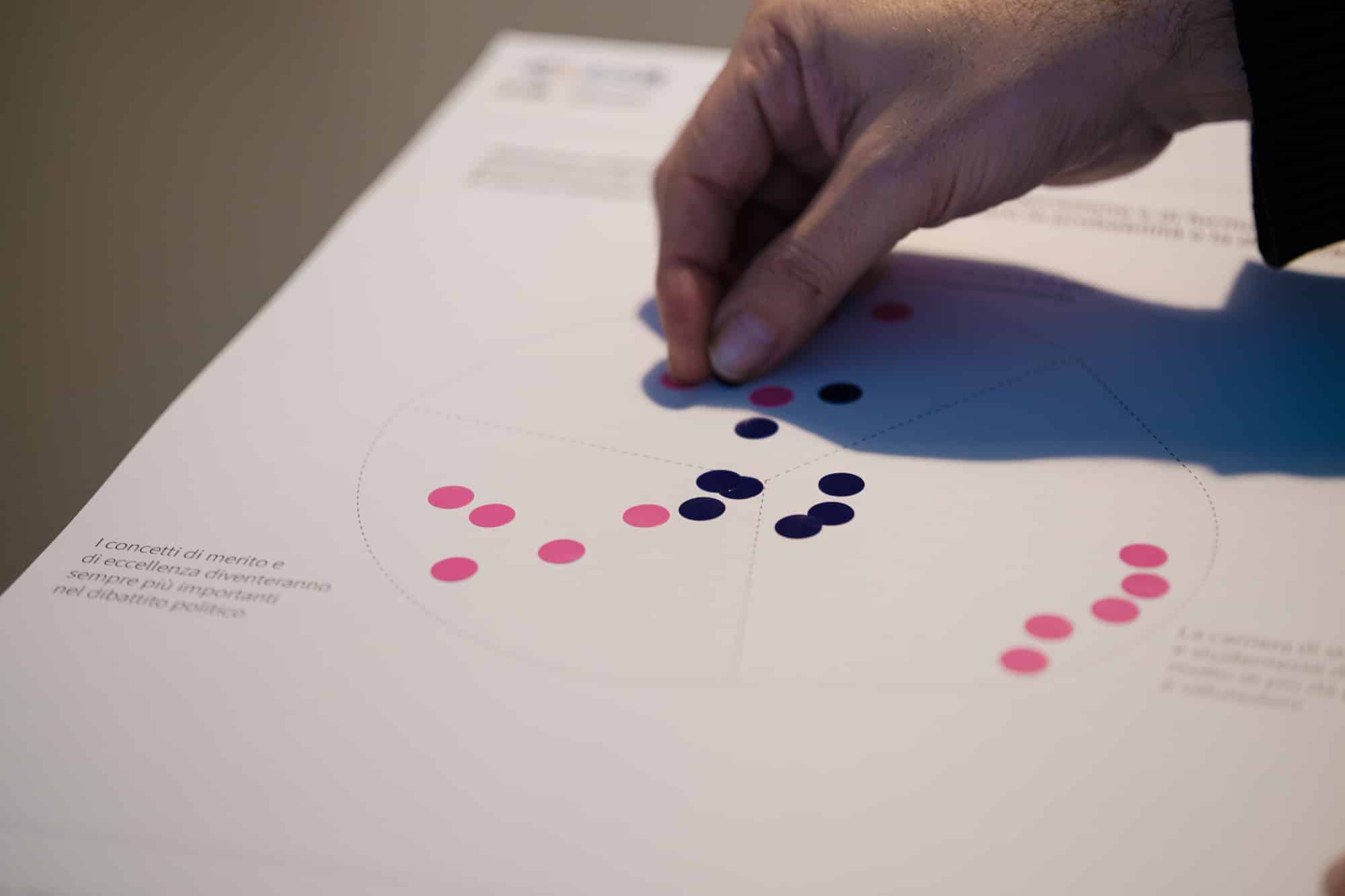
An alternative version presents different scenarios in which participants are invited to assess their plausibility and desirability using a visualisation with arrows. Respondents can place dots along each arrow to indicate the degree of desirability (more desired or undesired), and likelihood (more probable or improbable).
Figure 8 – Alternative format for collecting participants positioning on scenarios
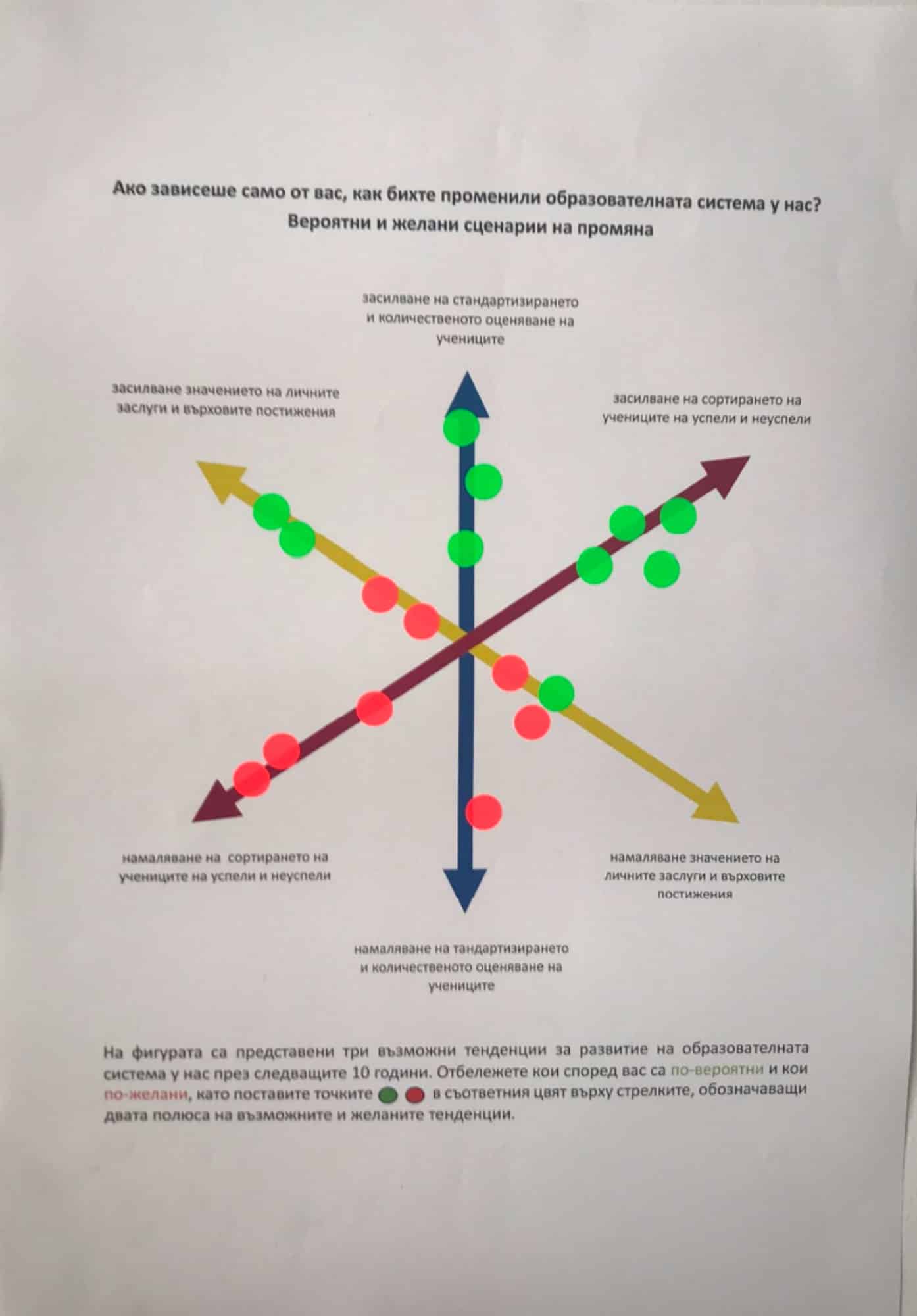
- (10 minutes) With the group’s general picture displayed, participants are asked to comment on their position and what they see.
Figure 9 – Results from participants assessment on the diagram is shown and commented

- (5 minutes) Introduce poster (C) by displaying its A2 version on the walls and circulate an A4 version. Explain the poster. Then, check and comment on any similarities or differences between the participants’ opinions on future scenarios and the project results.
Give participants a few minutes to gather their ideas and experiences by following this instruction: Looking at each of the three scenarios, how do you feel about it? What impact and consequences will it have on you and the context in which you live, study, and/or work? Provide them with sticky notes or paper to write down some keywords.
Figure 10 – Participants commenting on impacts in their contexts
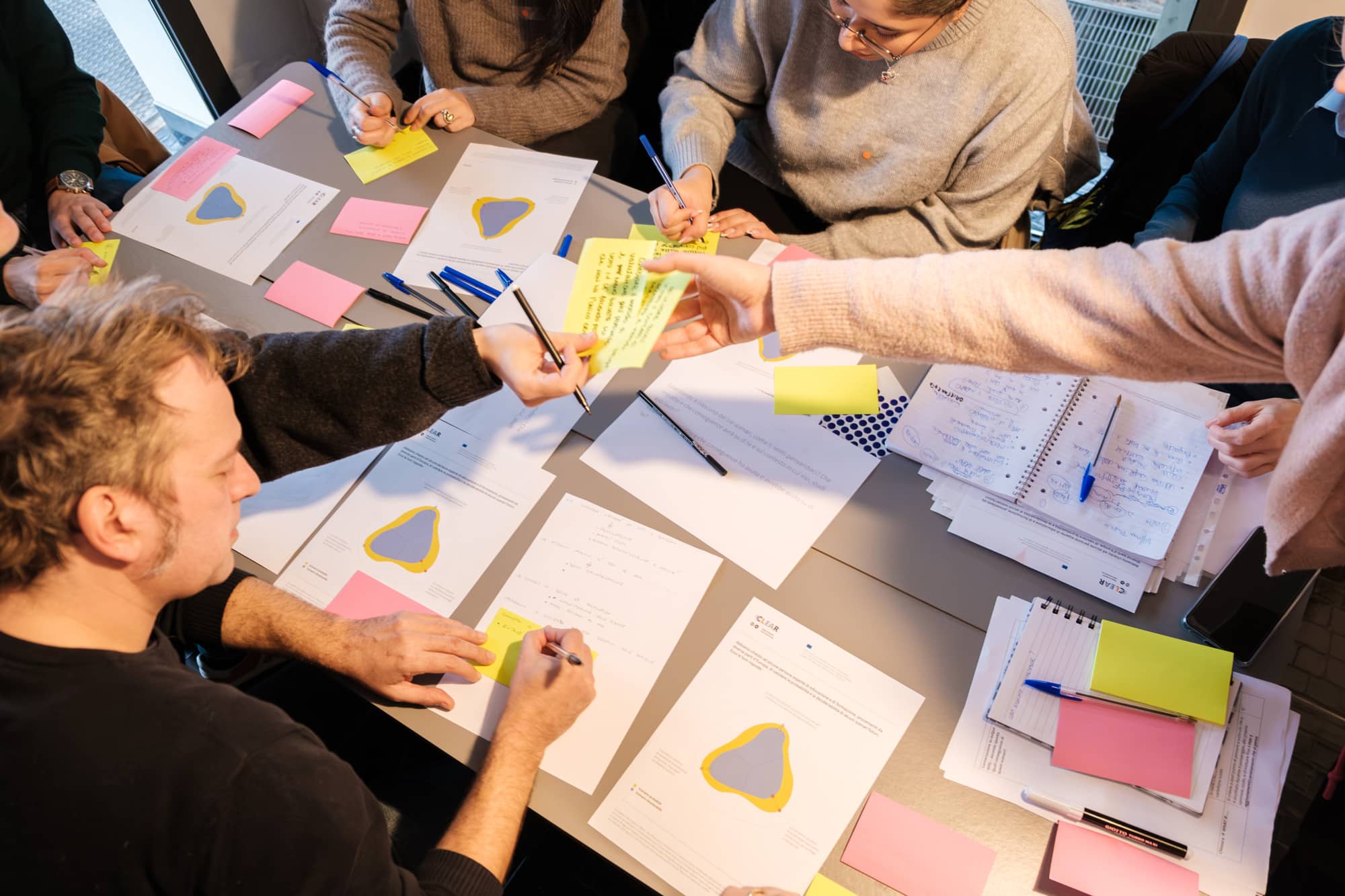
- (30 minutes) Ask participants to share their experiences and ideas in a first round of discussion. The facilitator can’t briefly comment on emerging points, referring to WP6 findings and other relevant research results. Participants may then engage in further discussion.
- (5 minutes) Facilitator’s instruction: After listening to your colleagues’ stories and considering CLEAR findings, please indicate up to three adjustments you think could make the three scenarios more desirable.
- (5 minutes) Facilitator’s final comments, feedback about the meeting, and closing thanks.
A shorter workshop can also be proposed, designed for a 75-minute group session with five to ten participants, one facilitator and one note-taker.
- (5 minutes) Start with a general update on the project and present the meeting focus and objectives.
- (10 minutes) Introduce poster (C) by displaying its A2 version on the walls and circulating an A4 version among participants. Explain the poster and give participants time to look at it and ask questions for clarifications.
- (10) Give participants time to gather their ideas and experiences by following this instruction: Looking at each of the three scenarios, how do you feel about it? What impact and consequences might it have on you and the context in which you live, study, and/or work? Provide them with sticky notes or paper to note down their thoughts.
- (30 minutes) Ask participants to share their experiences and ideas in an initial round of sharing. Individual positions are not commented on; Instead, the overall orientation is reviewed, possibly with brief comment on WP6 findings and other relevant research results.
- (5 minutes) Facilitator’s instructions: After listening to your colleagues’ stories and considering the project’s findings, indicate up to three adjustments you think could make the three scenarios more desirable.
- (10 minutes) Ask participants to share their thoughts and proposals.
- (5 minutes) Facilitator’s final comments, meeting feedback, and closing thanks.
The workshop examples also work with two people guiding the activity per group: one as facilitator and the other as researcher. If there is only one person per group, it is recommended to find a workaround for note-taking, such as asking participants to write down their thoughts on paper or sticky notes.
When the core activities are concluded, invite everyone to join the plenary again. If needed, allow a few more minutes for groups to finish their discussions. Also, make sure all groups have finalized their tasks. During the closing session, we suggest to
- Thank the participants for their work in the subgroups, explicitly acknowledging their valuable contribution to the research.
- Remind everyone that a summary report of the event will be shared. While this summary will be circulated afterwards, it is still useful for each subgroup to briefly share a few ideas from the work done— not a full report-back, but some key points — during the plenary. Keep this sharing focused and concise. This moment can be facilitated either by a researcher/facilitator or by a participant who has volunteered as a spokesperson.
- Propose a final round of reflections, with feedback-oriented questions such as How did today go for you, especially compared to your expectations? or What suggestions would you give to others organizing similar participatory events?
- Thank all participants again, as well as the location provider (if present).
- If possible, create space for an informal moment with participants, such as an aperitivo or a coffee break. These informal moments are valuable for gathering additional feedback and strengthening relationships.
In a participatory process, the post-event phase is just as important as the implementation of the event itself. Depending on the design and objectives of the participatory process, different actions can be carried out after an event or an activity. Recognizing participation as a mutual process also means to give something back to the participants – a return for what they shared during the event. This feedback should be brief, clear, and easy to read. Participants might also appreciate receiving photos from the event. Sending the report is also a good opportunity to thank them again for their involvement and interest.
